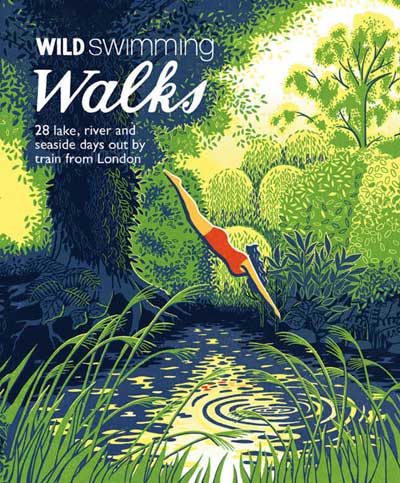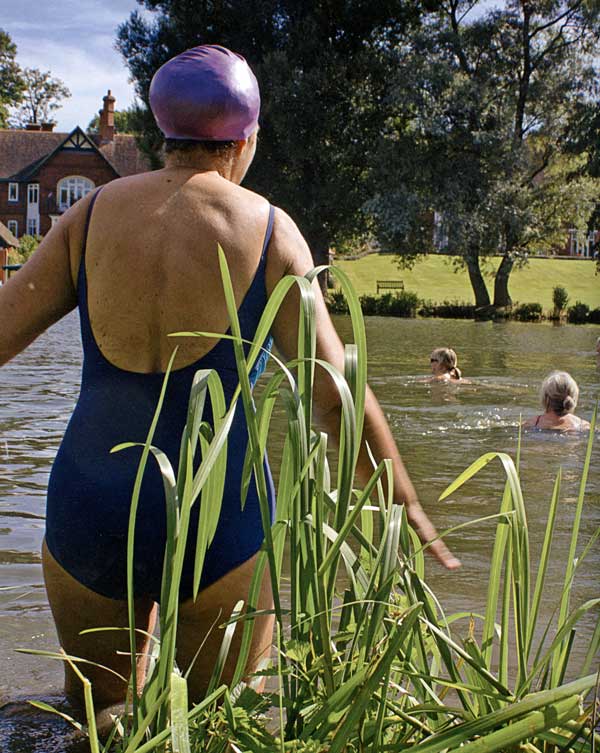
Wild Swimming Walks (Wild Things Publishing)
by Kenwood Ladies Pond Association
Review by Tim Sutton:
Just in time for a hopefully baking hot Summer, the ladies of Kenwood Pond (Hampstead Ladies Pond) have put together a collection of their favourite 28 lake, river and seaside days out. These excursions vary in length from a 3·5 mile stroll through Hampstead, to a 16 mile hike around Marlow, with detailed maps, train routes, walking instructions and loads of photographs. Be warned, the emphasis is very much on walks (with swims) so be prepared for a lot of kissing gates.
These trips out of ‘the big smoke’ extend from Oxford in the West to Margate in the East, Arundel in the South to the village of Shepreth in the North. Included en route are descriptions of plant life such as the Poisonous Hemlock, Water Dropwart, Wild Carrot and Ladies Bedstraw; birds including woodpeckers, greenfinches, mallards and little grebes; also butterflies like the Red Admiral, Specked Wood, Meadow Brown and Common Blue. The place names also evoke the great outdoors such as Hollybread Wood, the Crab and Winkle Way, Tofts Chase and Sunny Sands.
 Included is a history of the Hampstead ponds which although appearing natural were created as reservoirs between the 17th and 19th Century. These were nearly lost to developers until the Hampstead Heath Act of 1871 allowed the Metropolitan Boards of Works to purchase parts of the land thus preserving the ‘natural aspect and state’ of the Heath. Recently the ponds have again been threatened with proposed engineering work to strengthen the dams which some argue will detract from the natural aspect of the landscape. A reminder that we should never take our swimming places for granted.
Included is a history of the Hampstead ponds which although appearing natural were created as reservoirs between the 17th and 19th Century. These were nearly lost to developers until the Hampstead Heath Act of 1871 allowed the Metropolitan Boards of Works to purchase parts of the land thus preserving the ‘natural aspect and state’ of the Heath. Recently the ponds have again been threatened with proposed engineering work to strengthen the dams which some argue will detract from the natural aspect of the landscape. A reminder that we should never take our swimming places for granted.
Of course, to swim away from the safety of our pools and lidos we need to take extra care. For rivers and lakes, the ladies warn of weeds, algae, weirs and deep water. In the sea, to be aware of tides, currents and slippery exit points. Recommended equipment include a spare dry costume for that extra sneaky swim (optional for ‘secluded’ spots), warm clothes for afterwards and a brightly coloured hat so that boats can see you coming. I would also add to that list a decent picnic and lashings of ginger beer.
Before this book I had never really considered the issues of swimming in the countryside, but the introduction points out that although the campaign for footpaths has been won by the Ramblers Association, there are still too many “No Swimming” signs in Britain’s lakes and rivers. The issues of pollution and sewage have been a problem in the past, but water quality is improving. The stumbling block seems to be landowners who want to use their waterways for more lucrative activities such as fishing and boating.
The enthusiasm of this book is very compelling and I have certainly been inspired to try out a couple of the ladies’ walks. The one from Southease to Newhaven, via ‘Poverty Bottom’ sounds interesting.

